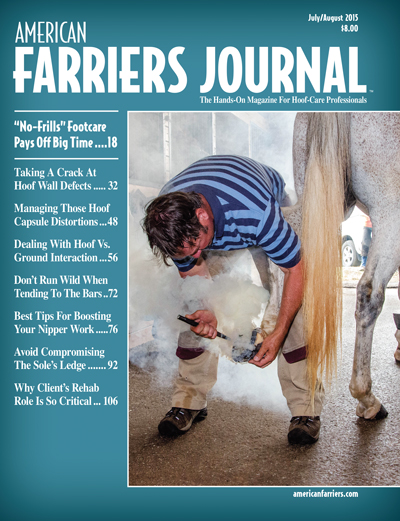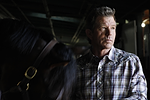Advertise Follow Us
American Farriers Journal

View Archived Issues
July/August 2015
Volume: 41
Edition: 5
American Farriers Journal is the “hands-on” magazine for professional farriers, equine veterinarians and horse care product and service buyers.
-
Table Of Contents
Table Of Contents
Shoeing for a LivingNo-Frills Footcare In North Georgia
Commitment to getting feet to a “solid” state is the cornerstone of Doug Workman’s farrier practiceRead MoreHow to Convince Clients that their Rehab Role is Vital
Tips to get owners to stick to the plan while their horse is recovering from injuryRead MoreTaking a Crack at Hoof Wall Defects
How failures occur and the best techniques for farriers to help them healRead MoreThoughts on Managing Hoof Capsule Distortion
Bob Pethick provides usable insights on distortion and considerations when addressing these concerns as a farrierRead MoreConcussion and the Equine Foot
Examining the multitude of factors influencing the interaction of the hoof and the groundRead MoreInfrared Thermography: Fun Toy or Practical Tool?
Two case studies show how smartphone infrared cameras could be used by farriersRead MoreBuying, Using And Caring For Your Nippers
Reliable tips for selecting, using and maintaining one of your most important toolsRead MoreForging Tips from the Heartland
Gregory family celebrates the 20th anniversary of the school’s openingRead MoreExperiences Help Veterans Rise to the Top
Military attributes provide a framework for success in farrieryRead MoreSupporting the Ledge
Thoughts on how the “ledge” provided by the solar perimeter is compromised, and suggestions on addressing thisRead MoreSpotlight on Hoof-Care: Education First: It’s Not Just About Winning
Interactive clinics and competition contribute to the Northern California Classic’s 30-year tradition of continuing educationRead More -
Featured Articles
Featured Articles
Taking a Crack at Hoof Wall Defects
How failures occur and the best techniques for farriers to help them healRead MoreShoeing for a LivingNo-Frills Footcare In North Georgia
Commitment to getting feet to a “solid” state is the cornerstone of Doug Workman’s farrier practiceRead More - Digital Edition
-
Online Extras
Online Extras












